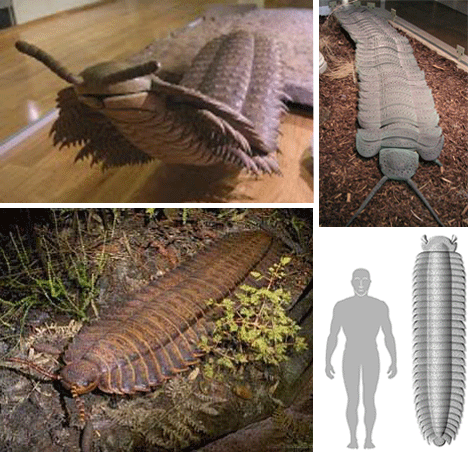Science
Related: About this forumInsects cut down to size by birds
The evolution of birds may have helped to keep insects from growing into much larger species, scientists have said. Faced with an airborne predatory threat, the creatures stayed small to be more manoeuvrable, it is believed.
Throughout earth's history, giant insects evolved during periods when the atmosphere was rich in oxygen. They reached their largest size about 300 million years ago, when dragonfly-like creatures called griffinflies, with wingspans up to 28 inches wide, ruled the sky.
http://www.independent.co.uk/environment/nature/insects-cut-down-to-size-by-birds-7815155.html
Silent3
(15,424 posts)mopinko
(70,294 posts)it's why we don't have giant bugs and poisonous snakes, i tell them. please don't tell me i am wrong. i ain't moving.
eppur_se_muova
(36,314 posts)home of flightless kiwis and parrots ...


laconicsax
(14,860 posts)Canuckistanian
(42,290 posts)One female, filled with eggs, holds the record for the heaviest insect ever measured - 70g (2.5 ounces)
nuxvomica
(12,457 posts)Now that's crossed off the list. ![]()
eppur_se_muova
(36,314 posts)
(OK, that's Tasmania, not NZ, but I couldn't resist.
Solly Mack
(90,795 posts)Canuckistanian
(42,290 posts)I wouldn't want to meet one of these.


happyslug
(14,779 posts)Last edited Thu Jun 7, 2012, 02:53 PM - Edit history (1)
About 145-150 million years ago was the end of the Jurassic period (200-145 million years ago) and the beginning of the Cretaceous period:
Jurassic Period:
http://en.wikipedia.org/wiki/Jurassic
Cretaceous period (145-65 Million years ago):
http://en.wikipedia.org/wiki/Cretaceous
Sauropods (Brontosaurs type animals) were the main large animals during the Jurassic, with the end of the Jurassic and the beginning of the Cretaceous the main animals switched to Ceratopsians and Hadrosaurs
http://en.wikipedia.org/wiki/Sauropod
Cretaceous period (145-65 Million years ago):
http://en.wikipedia.org/wiki/Cretaceous
List of Dinosaurs in the Cretaceous period:
classic sauropods of the Jurassic period had pretty much died out, but their descendants, the lightly armored titanosaurs, spread to every continent on earth. Ceratopsians (horned, frilled dinosaurs) like Styracosaurus and Triceratops became abundant, as did hadrosaurs (duck-billed dinosaurs), which were especially common at this time, roaming the plains of North America and Eurasia in vast herds. Among the last dinosaurs left standing by the time of the K/T Extinction were the plant-eating ankylosaurs, notably Ankylosaurus and Euoplocephalus, and the pachycephalosaurs ("thick-headed lizards"![]() . The early mammals still kept to themselves; they would only emerge from the shadows after the dinosaurs had gone extinct.
. The early mammals still kept to themselves; they would only emerge from the shadows after the dinosaurs had gone extinct.
http://dinosaurs.about.com/od/dinosaurbasics/a/dinosaurages_4.htm
The big difference between the Jurassic and Cretaceous is the breakup of the super continent Pangaea. It was still more or less intact (Through breaking up) during the Jurassic, but it clearly broke up during the Cretaceous. This meant a wetter Cretaceous then the previous Jurassic period. It also means more and more land was separated from other lands, thus you had smaller and smaller environmental areas. In such smaller areas, food is limited thus it is better to be small, so you can survive on the limited food supply, then large and have to spend more time feeding.
Another factor, about 140 million years ago flowering plants first appeared and became the dominate plant form:
More on flowering plants and their appearance and their growth to be the dominate plant in this planet:
http://en.wikipedia.org/wiki/Angiosperm
Thus while birds may have been a factor, the bigger factor may be the breakup of the Super-continents AND the spread of flowering plants.
One last comment, bats eat more insects then birds, and dominant the sky when it is nighttime. There is a mammal's tooth from the Cretaceous that some scientists believe is a bat's tooth. Bats fossils tend NOT to survive, thus we have no complete body of bats till about 50 million years ago.
http://en.wikipedia.org/wiki/Bat
Study on birds vs bats and insect consumption (Bats win easily, but birds AND bats beat just birds and or just bats):
http://www.batcon.org/index.php/media-and-info/bats-archives.html?task=viewArticle&magArticleID=1013
Just pointing out, the break up of the Continent and the possible introduction of bats may have had a greater affect then birds on the size of insects.
Mammals existed during the Jurassic and Cretaceous periods but appears to be mostly insect eaters:
http://www.newscientist.com/article/dn6874-large-mammals-once-dined-on-dinosaurs.html
http://en.wikipedia.org/wiki/Repenomamus
http://en.wikipedia.org/wiki/Evolution_of_mammals
Side Note: Today, oxygen makes up just under 21% of the air in the Atmosphere:
http://en.wikipedia.org/wiki/Atmosphere_of_Earth
This tends to be the percentage of Oxygen during most of the ages of the earth when you had living creatures larger then one celled plants and animals. From 542 Million years ago till today, Oxygen levels have been between 15-30% of the atmosphere.
http://en.wikipedia.org/wiki/Geological_history_of_oxygen
Except for about 300 million years ago (when Oxygen level hit over 35%) oxygen levels has stayed under 25% of the atmosphere.
http://en.wikipedia.org/wiki/Geological_history_of_oxygen
The significance of this high Oxygen content is that it was possible to absorb more Oxygen through the skin (as most insects do) then such insects can do today. Increase Oxygen intake permits any animal to get larger, thus the higher Oxygen content permitted insect to become larger without having to develop lungs (Which is how vertebrate creatures "solved" the problem of getting enough oxygen into a much larger body).
The problem is this high Oxygen content was 300 million years ago, NOT the 150 million years used in this paper. Thus the truly large insects had disappeared while before birds (or even Dinosaurs) appeared on the plant, through Reptiles did appear 320 million years ago).
Sorry, between the break up of the Continent that continued from 150 million years ago (and the subsequent smaller habitats), switch from Sauropods to Ceratopsians and Hadrosaurs, the appearance of Flowing Plants about 140 Million years ago would have had an impact, and the expansion of early mammals, including maybe bats, all would have had a greater impact on insect size then birds. This does not mean birds were NOT a factor, but you have to look at the whole picture not just one part of it.